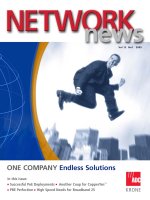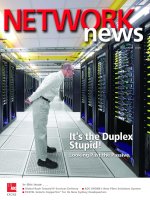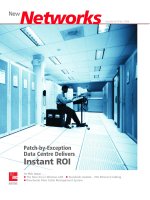ADC KRONE Network News - Vol.11 No.4 - 2004
Bạn đang xem bản rút gọn của tài liệu. Xem và tải ngay bản đầy đủ của tài liệu tại đây (1.63 MB, 16 trang )
In this issue . . .
Q
SAVE TIME AND SPACE
With HIGHBAND
®
Angled
Patch Panel
Q
CopperTen
™
Q&A
Q
Mitsubishi’s High Speed
Free Space Optics Solution
Vol 11 No4 2004
I
f there’s something you can count on in
the IT industry, it’s change. Driven by
constant innovation and an ever evolving
marketplace, the IT industry stands still
for no one. Successful companies thrive
on change using experience, ingenuity
and determination to stay ahead of the
pack.
With the recent amalgamation of ADC
and KRONE, we too are changing.
KRONE’s history has been a long and
distinguished one with over 75 years of
service, continually producing innovative
products to meet customer and
marketplace expectations.
One obvious change is that our two companies
will become one, leveraging the most from
existing brands and products that make up our
collective portfolio. We’re also discovering the
many great synergies that this will bring to you
our valued customers.
ADC and KRONE share over 145 years of
combined experience in the IT industry. On page
3, Bob Fitzgerald reviews the history of these two
extraordinary companies and their enduring
ingenuity.
The applications for KRONE’s latest technology,
CopperTen
™
, are continuing to grow and on page
5, Rob Milne discusses the importance of storage
area networks and the emergence of the Internet
SCSI SAN solution.
Also inside, Peter Meijer provides a cabling
standards update and presents an interesting
article on KRONE CopperTen that answers
questions now being generated in the
marketplace about this new technology.
Daniel Jackson introduces KRONE’s new
Category 6 Angled Patch Panel range, designed
to save you time and space.
On page 12, we look at how Mitsubishi Motors
have solved a remote connectivity problem with
the installation of a portable TereScope solution,
as well as GHD Pty Ltd’s recent deployment of a
now highly-prized HIGHBAND
®
25 Patch By
Exception solution.
We look forward to the remainder of 2004 and
are excited about the opportunities our new
partnership with ADC will bring, not only for
KRONE, but for you our customers.
Sincerely
Craig Jones
Managing Director
2
\
NETWORKnews
CHANGE: A KEY DRIVER FOR SUCCESS!
New milestone for KRONE, new direction for success
Business Articles
10 Cabling Standards Update
Customer Stories
12 Free Space Optics Provides Remote
Solution for Mitsubishi
14 HIGHBAND 25 Simplifies Patching for
Leading Engineers
Industry News
6 The Need For Speed... The SAN
Product News
9 HIGHBAND Category 6 Angled Patch
Panel
KRONE News
3 At Your Service!
3 Manufacturer of the Year
4 A Shared History of Innovation
11 Save Time, Train Online
16 Club KRONE Member Profile
Editor: Joanna Parsons
Art Direction: Nora Collins
Website: www.krone.com.au
Email:
CONTENTS
Copyright © 2001 KRONE Australia Holdings Pty. Limited
A
t KRONE our customers have always come
first and this year has been no exception, as
we continually aim to improve our service and
increase market share into new areas.
With the recent release of MIS magazine’s, Top
100 IT Users in Australia, it was pleasing to note
that KRONE’s position as the leading
connectivity supplier to those major clients has
continued to strengthen. KRONE proudly has
major installations in over 70 percent of these
accounts including Toyota, BHP, IAG,
Department of Defence, Westpac, etc.
Over the past few months, we’ve continued to
expand our services to the marketplace in an
endeavour to meet the increasing demands of our
customers. We are providing a dedicated team of
sales executives and engineers aimed at servicing
the needs of consultants and large-scale projects.
Customers will also note that we’re continuing
to improve our service internally, with the recent
decentralisation of our help desk to each of our
individual state offices. Our new internal sales
people will now be able to support your needs
from a local perspective, providing a more
personalised line of support.
With a strong first half already on the board,
we’re now looking forward to the second half of
2004 to continue implementing new strategies
and meeting the needs of the marketplace in an
effort to secure contracts and grow the KRONE
brand. I’m confident, that with a strong customer
focus and a dynamic sales team, coupled with
local support, that KRONE will continue to lead
the market.
Q
K
RONE Australia’s ongoing commitment to manu-
facturing excellence was recently recognised at the
Central Coast Manufacturers’ Association’s (CCMA)
2004 Innovation Awards.
Presented by The Honourable Ian Macfarlane MP,
Minister for Industry, Tourism and Resources, KRONE
received a record four awards including Large
Manufacturer of the Year.
Other awards included Innovation in Marketing,
Innovation in Training and Innovation in Product
Design, recognising KRONE’s combined expertise in the
successful design, development and marketing of
innovative connectivity products.
KRONE’s Daniel Johanson also received an individual
High Commendation, during the evening, for the
CCMA’s Apprentice/Trainee of the Year.
Q
NETWORKnews
\
3
AT YOUR SERVICE!
KRONE continues to improve customer focus and strengthen market share
MANUFACTURER OF THE YEAR!
KRONE celebrates local industry accolades
By Trevor Kleinert, RCDD,
National Sales Manager
Premis
NET
, Manager
Fibre Optics Division,
KRONE Australia
O
n 18 May 2004, the KRONE Group became a
part of ADC Telecommunications Inc. This
was indeed a major milestone for two companies
that have had a very similar history over the past
70 years or so.
If the two founders of the companies, Gustav
Krone and Ralph Allison, were alive today I
suspect that they would be pleased, as they were
both engineers who had a high expectation for
quality, performance and value. Both were
inventors who looked outside of the box to find
solutions that satisfied and exceeded customers’
expectations.
Let’s now use Jules Verne’s time machine to
take a trip back through time and explore the
history behind these two pioneering companies.
Just like the movie, let’s start from today and work
backwards...
BURSTING OF THE BUBBLE
The last five years has been somewhat of a roller
coaster for the industry and all its players. Both
KRONE and ADC have ridden through the
turmoil, first growing with the bubble and then
coming to grips with the downturn. In recent
times, focusing on their key customers and core
business, and at the same time managing to
provide leadership in the marketplace with such
products as KRONE’s CopperTen
™
10 Gigabit
Ethernet solution, and ADC’s Fibre to the Home
solution that is currently being deployed by
operators in the U.S.
DIGITAL REVOLUTION
Setting our dial back to the beginning of the
digital revolution, it is interesting to see that both
companies played an integral part in their
respective fields. ADC has been one of the leaders
in the digital central office with fibre and copper
digital cross connect systems. ADC played a
significant part with new operators in the
Australian market. Much of the optical
distribution frame and digital cross connect
installed during the 1990s period was supplied
and installed by ADC. At the same time, KRONE
supplied the majority of digital distribution frame
equipment for the incumbent operator in
Australia.
In this digital age, both companies diversified
from their traditional telco markets into other
evolving digital markets such as the software and
enterprise LAN networks.
COMMUNICATIONS FOR EVERYONE
Turning the clock back further to the 70s. This was
an era when telephone and communications were
changing from a luxury item for a few, to a
household necessity for everyone. This was also a
time when network expansion in the western
world was at its peak. Both KRONE and ADC were
there. KRONE had just invented the renowned LSA-
PLUS
®
module, and this product was fast providing
the road to productivity gains for connecting the
mass of cable needed for network growth in the
era. At the same time, ADC had invented the
Bantam Jack which in itself is an industry standard
and has been used from carrier cross connect
systems through to jackfields and patching in the
broadcast industry. This was a period of expansion
4
\
NETWORKnews
A SHARED HISTORY OF INNOVATION
A historical correlation of two extraordinary network connectivity companies
and their enduring ingenuity.
By Bob Fitzgerald,
VP Regional Director,
Indo-Pac Region, ADC
ADC and KRONE
present day facilities.
for both companies in their traditional home
markets of Germany and the United States. It was
also a time when they ventured out beyond their
traditional borders into the world markets and
established their global footprint.
BAKERLITE ERA
We now wind back the dial to the Bakerlite Era.
These were the days when connectors were built
like battleships. Both KRONE and ADC were
experts in the modern field of materials such as
bakerlite plastics and solder connection
technology. In the U.S., ADC was building jacks
and jackfields for the audio and broadcast
industry. Meanwhile, in Germany, KRONE was
manufacturing solder blocks and bakerlite
telephones for the German Bundespost. Both
companies had reached a level of critical mass,
where they had an established product line,
sound engineering and a name in their respective
markets. No doubt the founders of each company
had a vision for the future whereby one day
engineering materials would progress beyond the
bounds of bakerlite.
FOUNDING DAYS
Now we go all the way back to the early 30s
where we find two engineers, one in Berlin,
Germany and one in Minnesota in the U.S. The
furthermost thing in their minds would have been
the fact that 70 years later the companies that
they each founded would merge into a single
world leading entity. No doubt they were both
looking for a way to realise their dreams. They
had both been drawn towards the market for
electrical apparatus, as they believed that this was
the way of the future. It is hard to say just what it
was that led them to find their
successful product starts, but suffice
to say they were persistant and
successful.
As the wheel of time continues to turn we are
facing yet another exciting era. It would be nice
to have a time machine that looks forward, but
alas, we can only look backwards and reflect on
what was. But, what we can carry forward are
the lessons from the past and the combined 145
years of the history and experience of the
two companies founded by Gustav Krone and
Ralph Allison, engineers and entrepeneurs
extraordinaire!
Q
NETWORKnews
\
5
Above: ADC’s early manufacturing facility.
Right: ADC’s very first product, the audio meter.
Berlin 1930
Fa-Me-Ku ( a factory
for metal and plastic)
I
n the last issue (June/July 2004) of Network
News I outlined one of the future drivers for high
speed, 10 Gigabit networking in the horizontal;
Grid Computing. The grid computer environment
however, may still be a few years away from mass
acceptance and deployment by IT departments,
so I believe it salient to discuss a technology which
is readily available now and beyond the early
adopter stage. I would restate however, that
while technologies like Grid Computing maybe a
few years off yet for many, if an investment in
structured cabling solutions is being made now, it
will probably be in place for at least the next five
years and most likely up to ten; when
technologies like Grid Computing will be
mainstream.
A branch of distributed computing however,
that is now moving to extensive deployment
within the IT department is the Storage Area
Network, or SAN. Up until now, disk storage is
predominately directly attached (DAS) to the
server that requires the information from it to
process. In this form the storage is held captive
behind servers and is typically only accessible by
the server that is attached to it. This means that
the server and the applications that run on it
determine the capacity and utilisation of the data
stored on its attached storage subsystem.
Invariably these days in a reasonable sized IT
department there will be many servers performing
different functions. Some servers will be
approaching crisis with near full disks and other
servers with plenty of available capacity for that
server’s applications.
The other important issue with respect to
directly attached storage is reliability in regards to
accessing the stored data. Disk drives are complex
electromechanical devices built to very fine
tolerances. They quite often fail. There is a whole
science regarding the provisioning of redundant
arrays of disks on servers to provide failover
capability and good seek performance, this is
called RAID. Depending on the RAID solution
employed many disks can be duplicated on a
single server in mirrored and striped
configurations. This increases the number, cost
and complexity of drives required for each server.
Ultimately however, no matter what the level or
types of RAID systems used, backups of data are
still required to be taken of the data onto
removeable media which can be taken offsite to
guard against circumstances of total disk
subsystem failure and site disaster recovery
requirements. In a department which has multiple
servers, this requires different backup scenarios
and the handling and managing of large
quantities of media of potentially many different
6
\
NETWORKnews
THE NEED FOR SPEED:THE SAN
Applications for 10 Gigabit UTP Technology
By Rob Milne, Business
Development Manager,
KRONE Australia
“Riding the IP wave of technology
development and enhancements like
the introduction of 10 Gigabit
Ethernet, iSCSI provides a logical
unified infrastructure development
path for corporations and service
providers alike.” - Adaptec.
Server
SCSI
Discs
Discs
Discs Tape
Tape
Tape
IP
Network
Clients
Direct Attached Storage
SCSI
SCSI
Server
Server









